Foundations of EU Law: Analysis of EU Institutions and Procedures
VerifiedAdded on 2023/04/21
|18
|5355
|294
Homework Assignment
AI Summary
This assignment delves into key aspects of EU law, addressing the shift from the 'regulatory procedure with scrutiny' (Comitology procedure) to modern legislative processes like delegated and implementing acts, and the ordinary legislative procedure. It examines the allocation of powers between EU institutions, including the Commission, European Parliament, and Council of Ministers, particularly in areas such as environmental protection and air pollution regulations. The assignment analyzes the complexities of Article 340(2) TFEU concerning non-contractual liability and the difficulties individuals like Marc Bel might face in seeking compensation for damages caused by EU institutions or their servants, referencing relevant case law. Furthermore, the assignment explores the legal procedures and procedural issues in cases, such as the one brought by the City of Paris against the Commission, and the principles of legal certainty and legitimate expectations. The content also evaluates the distribution of power among national parliaments, the European Parliament, the Council of Ministers, and the Commission, concerning health and well-being of EU citizens with regard to air pollution, providing reasons for the suggested distribution.

Law
Page 1
Page 1
Paraphrase This Document
Need a fresh take? Get an instant paraphrase of this document with our AI Paraphraser
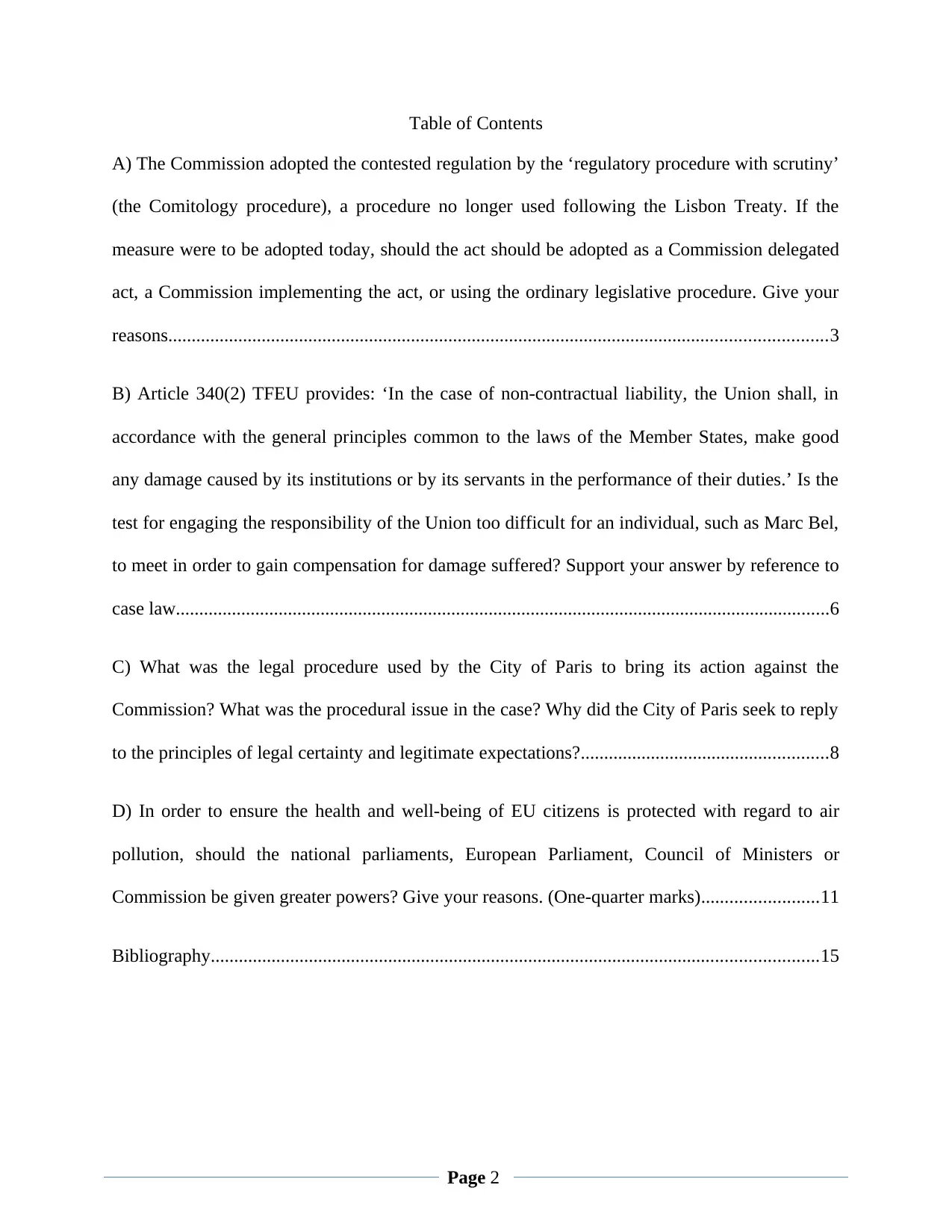
Table of Contents
A) The Commission adopted the contested regulation by the ‘regulatory procedure with scrutiny’
(the Comitology procedure), a procedure no longer used following the Lisbon Treaty. If the
measure were to be adopted today, should the act should be adopted as a Commission delegated
act, a Commission implementing the act, or using the ordinary legislative procedure. Give your
reasons.............................................................................................................................................3
B) Article 340(2) TFEU provides: ‘In the case of non-contractual liability, the Union shall, in
accordance with the general principles common to the laws of the Member States, make good
any damage caused by its institutions or by its servants in the performance of their duties.’ Is the
test for engaging the responsibility of the Union too difficult for an individual, such as Marc Bel,
to meet in order to gain compensation for damage suffered? Support your answer by reference to
case law............................................................................................................................................6
C) What was the legal procedure used by the City of Paris to bring its action against the
Commission? What was the procedural issue in the case? Why did the City of Paris seek to reply
to the principles of legal certainty and legitimate expectations?.....................................................8
D) In order to ensure the health and well-being of EU citizens is protected with regard to air
pollution, should the national parliaments, European Parliament, Council of Ministers or
Commission be given greater powers? Give your reasons. (One-quarter marks).........................11
Bibliography..................................................................................................................................15
Page 2
A) The Commission adopted the contested regulation by the ‘regulatory procedure with scrutiny’
(the Comitology procedure), a procedure no longer used following the Lisbon Treaty. If the
measure were to be adopted today, should the act should be adopted as a Commission delegated
act, a Commission implementing the act, or using the ordinary legislative procedure. Give your
reasons.............................................................................................................................................3
B) Article 340(2) TFEU provides: ‘In the case of non-contractual liability, the Union shall, in
accordance with the general principles common to the laws of the Member States, make good
any damage caused by its institutions or by its servants in the performance of their duties.’ Is the
test for engaging the responsibility of the Union too difficult for an individual, such as Marc Bel,
to meet in order to gain compensation for damage suffered? Support your answer by reference to
case law............................................................................................................................................6
C) What was the legal procedure used by the City of Paris to bring its action against the
Commission? What was the procedural issue in the case? Why did the City of Paris seek to reply
to the principles of legal certainty and legitimate expectations?.....................................................8
D) In order to ensure the health and well-being of EU citizens is protected with regard to air
pollution, should the national parliaments, European Parliament, Council of Ministers or
Commission be given greater powers? Give your reasons. (One-quarter marks).........................11
Bibliography..................................................................................................................................15
Page 2
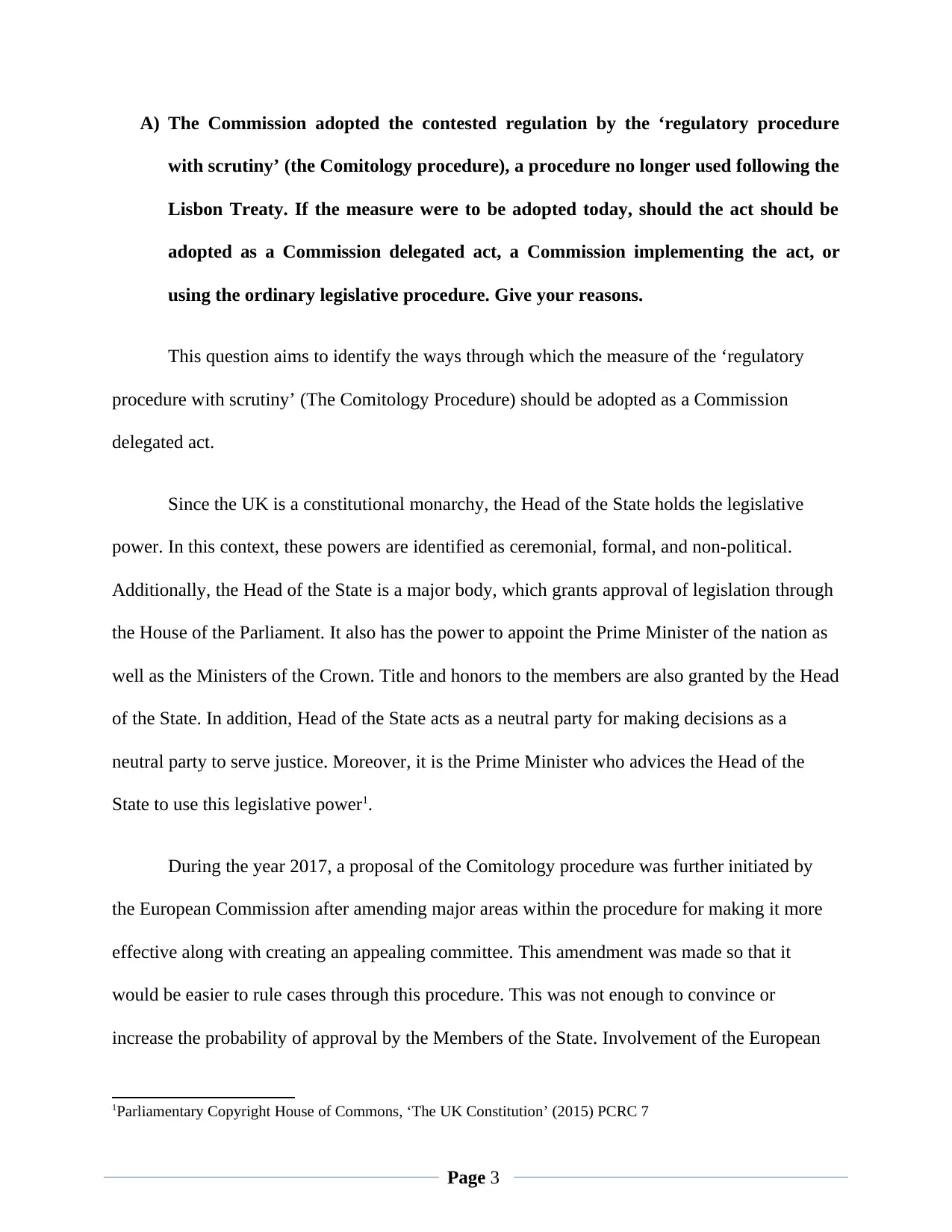
A) The Commission adopted the contested regulation by the ‘regulatory procedure
with scrutiny’ (the Comitology procedure), a procedure no longer used following the
Lisbon Treaty. If the measure were to be adopted today, should the act should be
adopted as a Commission delegated act, a Commission implementing the act, or
using the ordinary legislative procedure. Give your reasons.
This question aims to identify the ways through which the measure of the ‘regulatory
procedure with scrutiny’ (The Comitology Procedure) should be adopted as a Commission
delegated act.
Since the UK is a constitutional monarchy, the Head of the State holds the legislative
power. In this context, these powers are identified as ceremonial, formal, and non-political.
Additionally, the Head of the State is a major body, which grants approval of legislation through
the House of the Parliament. It also has the power to appoint the Prime Minister of the nation as
well as the Ministers of the Crown. Title and honors to the members are also granted by the Head
of the State. In addition, Head of the State acts as a neutral party for making decisions as a
neutral party to serve justice. Moreover, it is the Prime Minister who advices the Head of the
State to use this legislative power1.
During the year 2017, a proposal of the Comitology procedure was further initiated by
the European Commission after amending major areas within the procedure for making it more
effective along with creating an appealing committee. This amendment was made so that it
would be easier to rule cases through this procedure. This was not enough to convince or
increase the probability of approval by the Members of the State. Involvement of the European
1Parliamentary Copyright House of Commons, ‘The UK Constitution’ (2015) PCRC 7
Page 3
with scrutiny’ (the Comitology procedure), a procedure no longer used following the
Lisbon Treaty. If the measure were to be adopted today, should the act should be
adopted as a Commission delegated act, a Commission implementing the act, or
using the ordinary legislative procedure. Give your reasons.
This question aims to identify the ways through which the measure of the ‘regulatory
procedure with scrutiny’ (The Comitology Procedure) should be adopted as a Commission
delegated act.
Since the UK is a constitutional monarchy, the Head of the State holds the legislative
power. In this context, these powers are identified as ceremonial, formal, and non-political.
Additionally, the Head of the State is a major body, which grants approval of legislation through
the House of the Parliament. It also has the power to appoint the Prime Minister of the nation as
well as the Ministers of the Crown. Title and honors to the members are also granted by the Head
of the State. In addition, Head of the State acts as a neutral party for making decisions as a
neutral party to serve justice. Moreover, it is the Prime Minister who advices the Head of the
State to use this legislative power1.
During the year 2017, a proposal of the Comitology procedure was further initiated by
the European Commission after amending major areas within the procedure for making it more
effective along with creating an appealing committee. This amendment was made so that it
would be easier to rule cases through this procedure. This was not enough to convince or
increase the probability of approval by the Members of the State. Involvement of the European
1Parliamentary Copyright House of Commons, ‘The UK Constitution’ (2015) PCRC 7
Page 3
⊘ This is a preview!⊘
Do you want full access?
Subscribe today to unlock all pages.

Trusted by 1+ million students worldwide
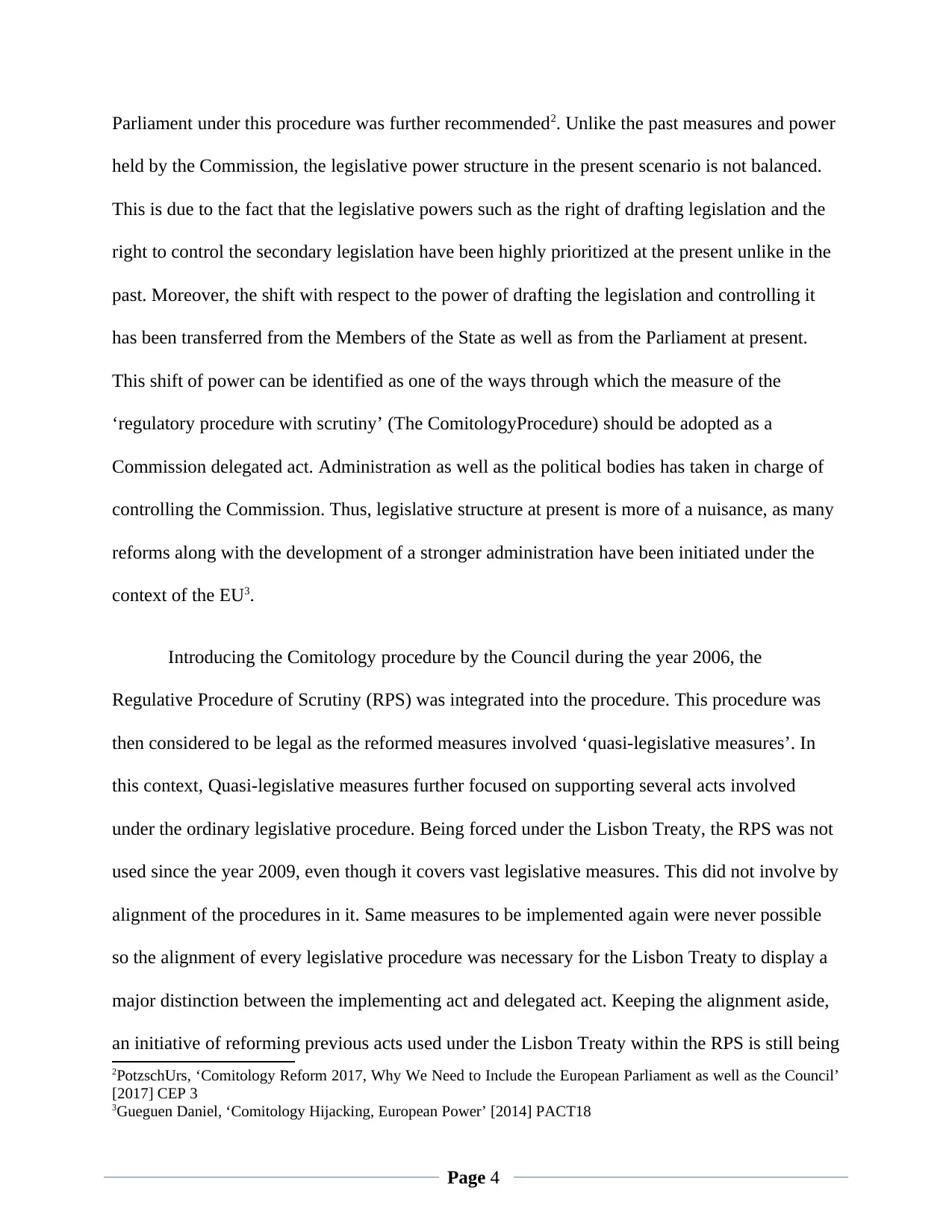
Parliament under this procedure was further recommended2. Unlike the past measures and power
held by the Commission, the legislative power structure in the present scenario is not balanced.
This is due to the fact that the legislative powers such as the right of drafting legislation and the
right to control the secondary legislation have been highly prioritized at the present unlike in the
past. Moreover, the shift with respect to the power of drafting the legislation and controlling it
has been transferred from the Members of the State as well as from the Parliament at present.
This shift of power can be identified as one of the ways through which the measure of the
‘regulatory procedure with scrutiny’ (The ComitologyProcedure) should be adopted as a
Commission delegated act. Administration as well as the political bodies has taken in charge of
controlling the Commission. Thus, legislative structure at present is more of a nuisance, as many
reforms along with the development of a stronger administration have been initiated under the
context of the EU3.
Introducing the Comitology procedure by the Council during the year 2006, the
Regulative Procedure of Scrutiny (RPS) was integrated into the procedure. This procedure was
then considered to be legal as the reformed measures involved ‘quasi-legislative measures’. In
this context, Quasi-legislative measures further focused on supporting several acts involved
under the ordinary legislative procedure. Being forced under the Lisbon Treaty, the RPS was not
used since the year 2009, even though it covers vast legislative measures. This did not involve by
alignment of the procedures in it. Same measures to be implemented again were never possible
so the alignment of every legislative procedure was necessary for the Lisbon Treaty to display a
major distinction between the implementing act and delegated act. Keeping the alignment aside,
an initiative of reforming previous acts used under the Lisbon Treaty within the RPS is still being
2PotzschUrs, ‘Comitology Reform 2017, Why We Need to Include the European Parliament as well as the Council’
[2017] CEP 3
3Gueguen Daniel, ‘Comitology Hijacking, European Power’ [2014] PACT18
Page 4
held by the Commission, the legislative power structure in the present scenario is not balanced.
This is due to the fact that the legislative powers such as the right of drafting legislation and the
right to control the secondary legislation have been highly prioritized at the present unlike in the
past. Moreover, the shift with respect to the power of drafting the legislation and controlling it
has been transferred from the Members of the State as well as from the Parliament at present.
This shift of power can be identified as one of the ways through which the measure of the
‘regulatory procedure with scrutiny’ (The ComitologyProcedure) should be adopted as a
Commission delegated act. Administration as well as the political bodies has taken in charge of
controlling the Commission. Thus, legislative structure at present is more of a nuisance, as many
reforms along with the development of a stronger administration have been initiated under the
context of the EU3.
Introducing the Comitology procedure by the Council during the year 2006, the
Regulative Procedure of Scrutiny (RPS) was integrated into the procedure. This procedure was
then considered to be legal as the reformed measures involved ‘quasi-legislative measures’. In
this context, Quasi-legislative measures further focused on supporting several acts involved
under the ordinary legislative procedure. Being forced under the Lisbon Treaty, the RPS was not
used since the year 2009, even though it covers vast legislative measures. This did not involve by
alignment of the procedures in it. Same measures to be implemented again were never possible
so the alignment of every legislative procedure was necessary for the Lisbon Treaty to display a
major distinction between the implementing act and delegated act. Keeping the alignment aside,
an initiative of reforming previous acts used under the Lisbon Treaty within the RPS is still being
2PotzschUrs, ‘Comitology Reform 2017, Why We Need to Include the European Parliament as well as the Council’
[2017] CEP 3
3Gueguen Daniel, ‘Comitology Hijacking, European Power’ [2014] PACT18
Page 4
Paraphrase This Document
Need a fresh take? Get an instant paraphrase of this document with our AI Paraphraser
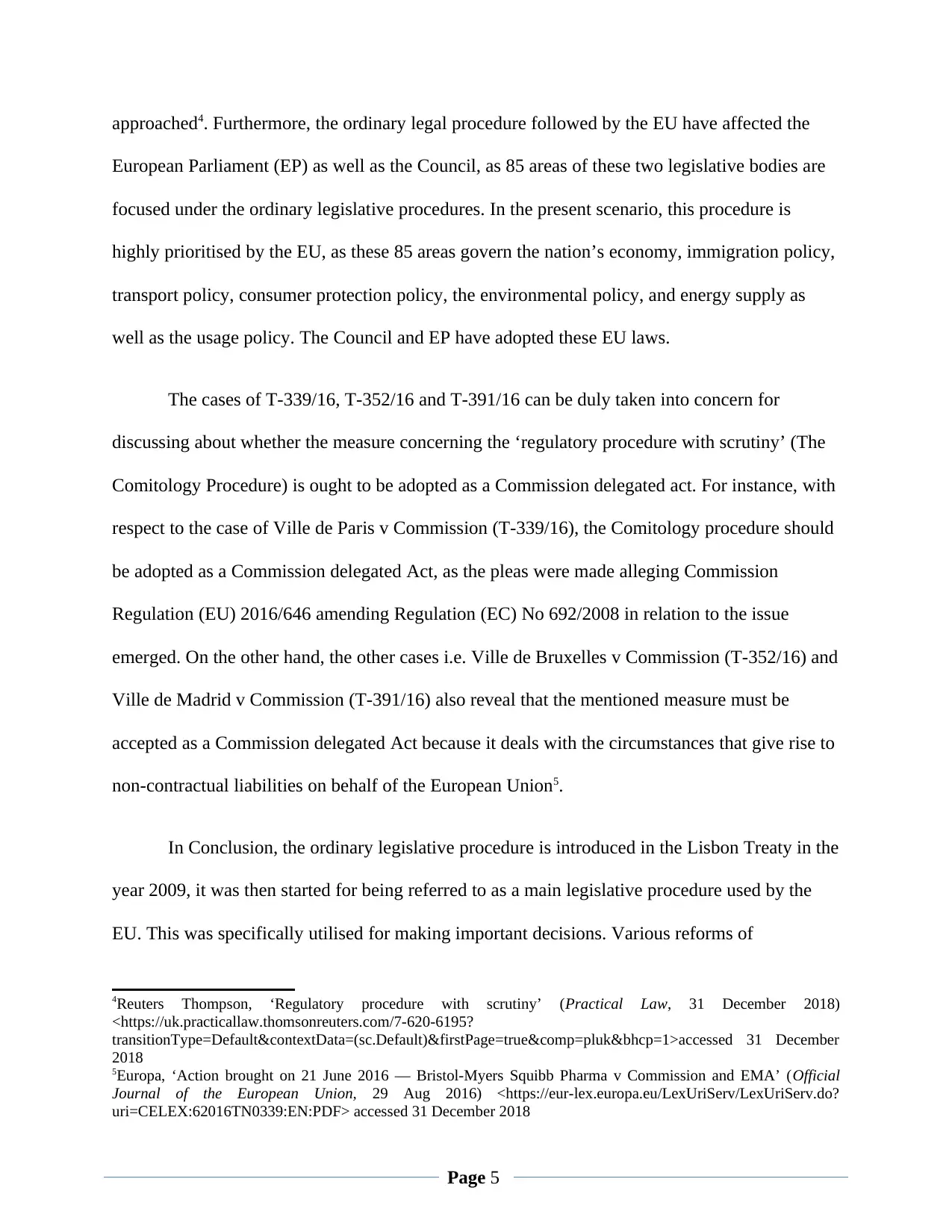
approached4. Furthermore, the ordinary legal procedure followed by the EU have affected the
European Parliament (EP) as well as the Council, as 85 areas of these two legislative bodies are
focused under the ordinary legislative procedures. In the present scenario, this procedure is
highly prioritised by the EU, as these 85 areas govern the nation’s economy, immigration policy,
transport policy, consumer protection policy, the environmental policy, and energy supply as
well as the usage policy. The Council and EP have adopted these EU laws.
The cases of T-339/16, T-352/16 and T-391/16 can be duly taken into concern for
discussing about whether the measure concerning the ‘regulatory procedure with scrutiny’ (The
Comitology Procedure) is ought to be adopted as a Commission delegated act. For instance, with
respect to the case of Ville de Paris v Commission (T-339/16), the Comitology procedure should
be adopted as a Commission delegated Act, as the pleas were made alleging Commission
Regulation (EU) 2016/646 amending Regulation (EC) No 692/2008 in relation to the issue
emerged. On the other hand, the other cases i.e. Ville de Bruxelles v Commission (T-352/16) and
Ville de Madrid v Commission (T-391/16) also reveal that the mentioned measure must be
accepted as a Commission delegated Act because it deals with the circumstances that give rise to
non-contractual liabilities on behalf of the European Union5.
In Conclusion, the ordinary legislative procedure is introduced in the Lisbon Treaty in the
year 2009, it was then started for being referred to as a main legislative procedure used by the
EU. This was specifically utilised for making important decisions. Various reforms of
4Reuters Thompson, ‘Regulatory procedure with scrutiny’ (Practical Law, 31 December 2018)
<https://uk.practicallaw.thomsonreuters.com/7-620-6195?
transitionType=Default&contextData=(sc.Default)&firstPage=true&comp=pluk&bhcp=1>accessed 31 December
2018
5Europa, ‘Action brought on 21 June 2016 — Bristol-Myers Squibb Pharma v Commission and EMA’ (Official
Journal of the European Union, 29 Aug 2016) <https://eur-lex.europa.eu/LexUriServ/LexUriServ.do?
uri=CELEX:62016TN0339:EN:PDF> accessed 31 December 2018
Page 5
European Parliament (EP) as well as the Council, as 85 areas of these two legislative bodies are
focused under the ordinary legislative procedures. In the present scenario, this procedure is
highly prioritised by the EU, as these 85 areas govern the nation’s economy, immigration policy,
transport policy, consumer protection policy, the environmental policy, and energy supply as
well as the usage policy. The Council and EP have adopted these EU laws.
The cases of T-339/16, T-352/16 and T-391/16 can be duly taken into concern for
discussing about whether the measure concerning the ‘regulatory procedure with scrutiny’ (The
Comitology Procedure) is ought to be adopted as a Commission delegated act. For instance, with
respect to the case of Ville de Paris v Commission (T-339/16), the Comitology procedure should
be adopted as a Commission delegated Act, as the pleas were made alleging Commission
Regulation (EU) 2016/646 amending Regulation (EC) No 692/2008 in relation to the issue
emerged. On the other hand, the other cases i.e. Ville de Bruxelles v Commission (T-352/16) and
Ville de Madrid v Commission (T-391/16) also reveal that the mentioned measure must be
accepted as a Commission delegated Act because it deals with the circumstances that give rise to
non-contractual liabilities on behalf of the European Union5.
In Conclusion, the ordinary legislative procedure is introduced in the Lisbon Treaty in the
year 2009, it was then started for being referred to as a main legislative procedure used by the
EU. This was specifically utilised for making important decisions. Various reforms of
4Reuters Thompson, ‘Regulatory procedure with scrutiny’ (Practical Law, 31 December 2018)
<https://uk.practicallaw.thomsonreuters.com/7-620-6195?
transitionType=Default&contextData=(sc.Default)&firstPage=true&comp=pluk&bhcp=1>accessed 31 December
2018
5Europa, ‘Action brought on 21 June 2016 — Bristol-Myers Squibb Pharma v Commission and EMA’ (Official
Journal of the European Union, 29 Aug 2016) <https://eur-lex.europa.eu/LexUriServ/LexUriServ.do?
uri=CELEX:62016TN0339:EN:PDF> accessed 31 December 2018
Page 5
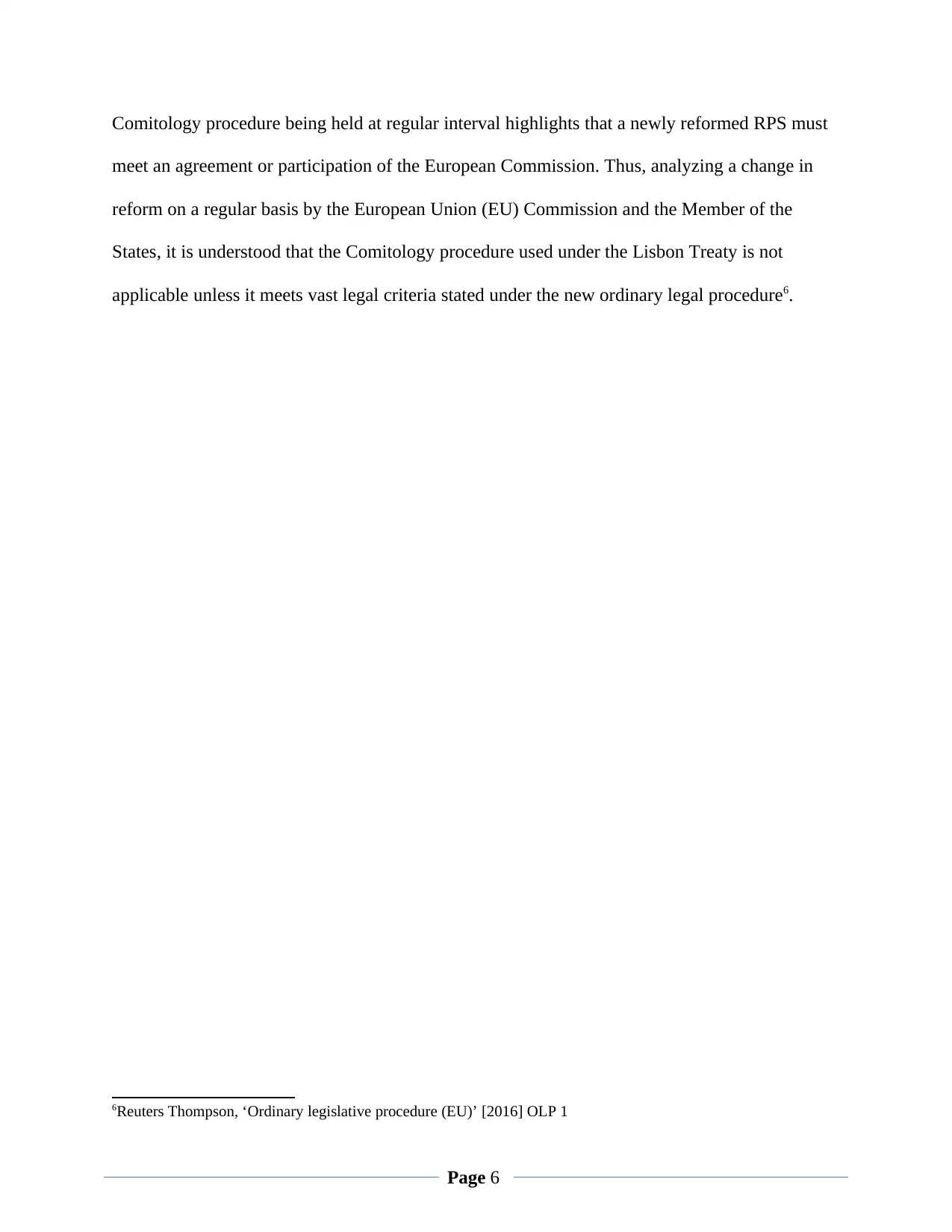
Comitology procedure being held at regular interval highlights that a newly reformed RPS must
meet an agreement or participation of the European Commission. Thus, analyzing a change in
reform on a regular basis by the European Union (EU) Commission and the Member of the
States, it is understood that the Comitology procedure used under the Lisbon Treaty is not
applicable unless it meets vast legal criteria stated under the new ordinary legal procedure6.
6Reuters Thompson, ‘Ordinary legislative procedure (EU)’ [2016] OLP 1
Page 6
meet an agreement or participation of the European Commission. Thus, analyzing a change in
reform on a regular basis by the European Union (EU) Commission and the Member of the
States, it is understood that the Comitology procedure used under the Lisbon Treaty is not
applicable unless it meets vast legal criteria stated under the new ordinary legal procedure6.
6Reuters Thompson, ‘Ordinary legislative procedure (EU)’ [2016] OLP 1
Page 6
⊘ This is a preview!⊘
Do you want full access?
Subscribe today to unlock all pages.

Trusted by 1+ million students worldwide
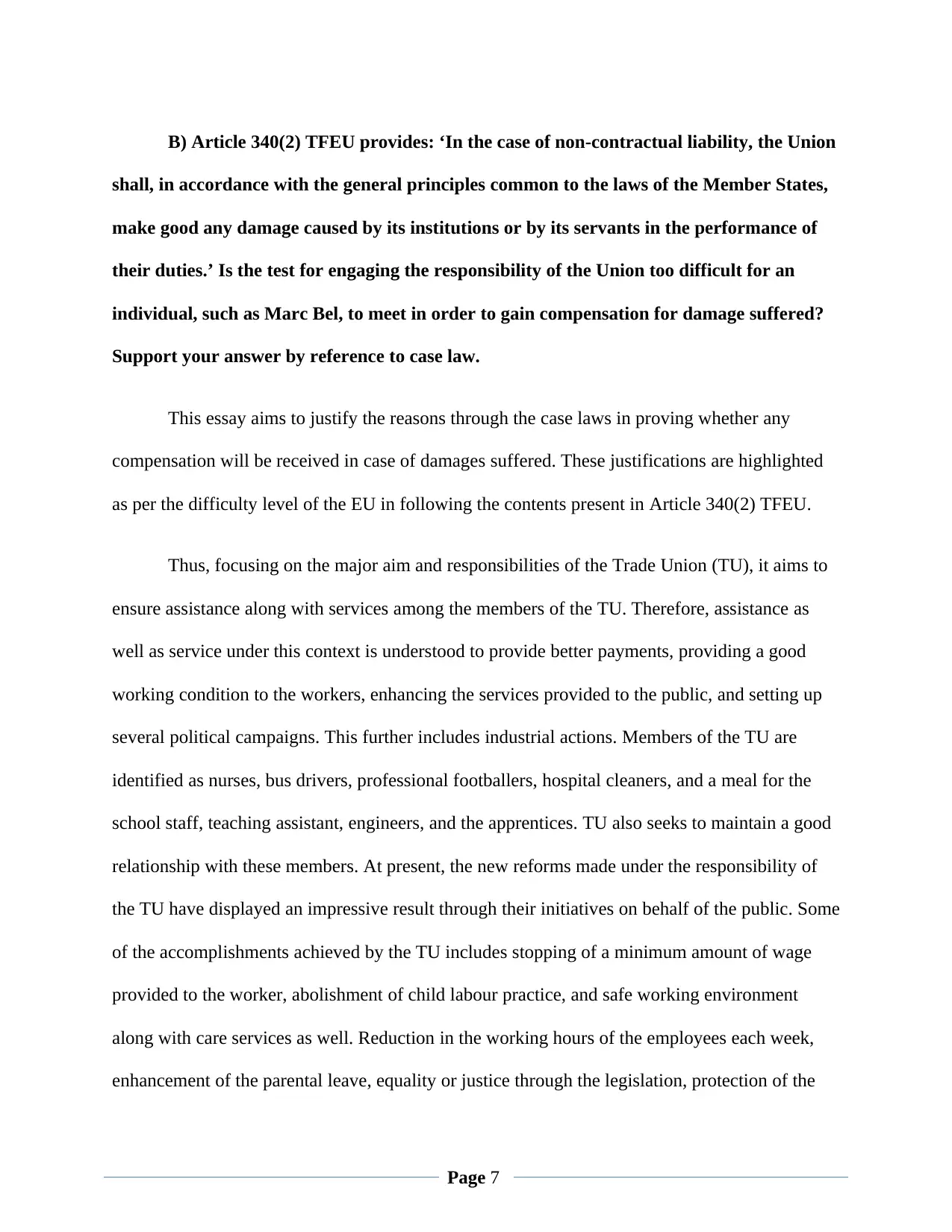
B) Article 340(2) TFEU provides: ‘In the case of non-contractual liability, the Union
shall, in accordance with the general principles common to the laws of the Member States,
make good any damage caused by its institutions or by its servants in the performance of
their duties.’ Is the test for engaging the responsibility of the Union too difficult for an
individual, such as Marc Bel, to meet in order to gain compensation for damage suffered?
Support your answer by reference to case law.
This essay aims to justify the reasons through the case laws in proving whether any
compensation will be received in case of damages suffered. These justifications are highlighted
as per the difficulty level of the EU in following the contents present in Article 340(2) TFEU.
Thus, focusing on the major aim and responsibilities of the Trade Union (TU), it aims to
ensure assistance along with services among the members of the TU. Therefore, assistance as
well as service under this context is understood to provide better payments, providing a good
working condition to the workers, enhancing the services provided to the public, and setting up
several political campaigns. This further includes industrial actions. Members of the TU are
identified as nurses, bus drivers, professional footballers, hospital cleaners, and a meal for the
school staff, teaching assistant, engineers, and the apprentices. TU also seeks to maintain a good
relationship with these members. At present, the new reforms made under the responsibility of
the TU have displayed an impressive result through their initiatives on behalf of the public. Some
of the accomplishments achieved by the TU includes stopping of a minimum amount of wage
provided to the worker, abolishment of child labour practice, and safe working environment
along with care services as well. Reduction in the working hours of the employees each week,
enhancement of the parental leave, equality or justice through the legislation, protection of the
Page 7
shall, in accordance with the general principles common to the laws of the Member States,
make good any damage caused by its institutions or by its servants in the performance of
their duties.’ Is the test for engaging the responsibility of the Union too difficult for an
individual, such as Marc Bel, to meet in order to gain compensation for damage suffered?
Support your answer by reference to case law.
This essay aims to justify the reasons through the case laws in proving whether any
compensation will be received in case of damages suffered. These justifications are highlighted
as per the difficulty level of the EU in following the contents present in Article 340(2) TFEU.
Thus, focusing on the major aim and responsibilities of the Trade Union (TU), it aims to
ensure assistance along with services among the members of the TU. Therefore, assistance as
well as service under this context is understood to provide better payments, providing a good
working condition to the workers, enhancing the services provided to the public, and setting up
several political campaigns. This further includes industrial actions. Members of the TU are
identified as nurses, bus drivers, professional footballers, hospital cleaners, and a meal for the
school staff, teaching assistant, engineers, and the apprentices. TU also seeks to maintain a good
relationship with these members. At present, the new reforms made under the responsibility of
the TU have displayed an impressive result through their initiatives on behalf of the public. Some
of the accomplishments achieved by the TU includes stopping of a minimum amount of wage
provided to the worker, abolishment of child labour practice, and safe working environment
along with care services as well. Reduction in the working hours of the employees each week,
enhancement of the parental leave, equality or justice through the legislation, protection of the
Page 7
Paraphrase This Document
Need a fresh take? Get an instant paraphrase of this document with our AI Paraphraser
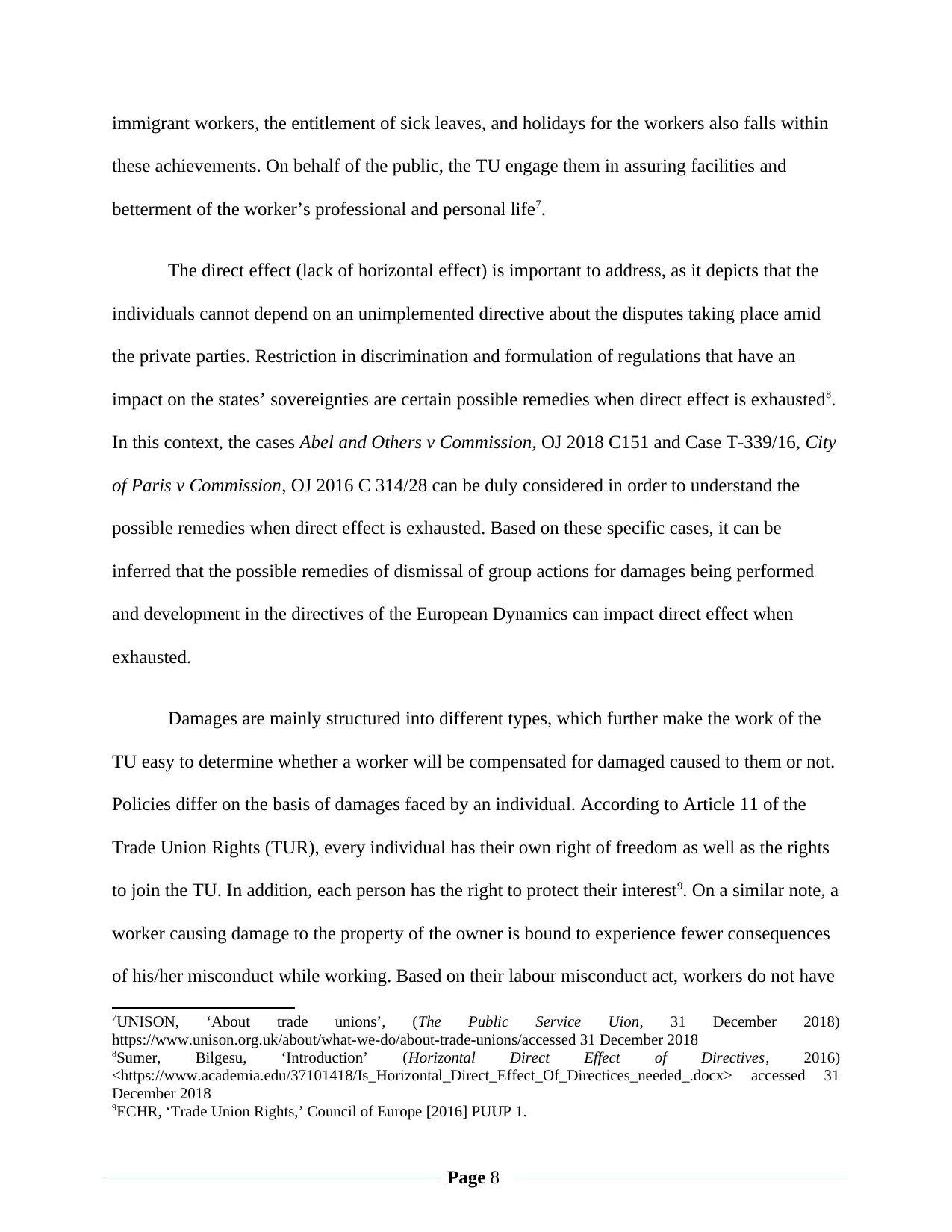
immigrant workers, the entitlement of sick leaves, and holidays for the workers also falls within
these achievements. On behalf of the public, the TU engage them in assuring facilities and
betterment of the worker’s professional and personal life7.
The direct effect (lack of horizontal effect) is important to address, as it depicts that the
individuals cannot depend on an unimplemented directive about the disputes taking place amid
the private parties. Restriction in discrimination and formulation of regulations that have an
impact on the states’ sovereignties are certain possible remedies when direct effect is exhausted8.
In this context, the cases Abel and Others v Commission, OJ 2018 C151 and Case T-339/16, City
of Paris v Commission, OJ 2016 C 314/28 can be duly considered in order to understand the
possible remedies when direct effect is exhausted. Based on these specific cases, it can be
inferred that the possible remedies of dismissal of group actions for damages being performed
and development in the directives of the European Dynamics can impact direct effect when
exhausted.
Damages are mainly structured into different types, which further make the work of the
TU easy to determine whether a worker will be compensated for damaged caused to them or not.
Policies differ on the basis of damages faced by an individual. According to Article 11 of the
Trade Union Rights (TUR), every individual has their own right of freedom as well as the rights
to join the TU. In addition, each person has the right to protect their interest9. On a similar note, a
worker causing damage to the property of the owner is bound to experience fewer consequences
of his/her misconduct while working. Based on their labour misconduct act, workers do not have
7UNISON, ‘About trade unions’, (The Public Service Uion, 31 December 2018)
https://www.unison.org.uk/about/what-we-do/about-trade-unions/accessed 31 December 2018
8Sumer, Bilgesu, ‘Introduction’ (Horizontal Direct Effect of Directives, 2016)
<https://www.academia.edu/37101418/Is_Horizontal_Direct_Effect_Of_Directices_needed_.docx> accessed 31
December 2018
9ECHR, ‘Trade Union Rights,’ Council of Europe [2016] PUUP 1.
Page 8
these achievements. On behalf of the public, the TU engage them in assuring facilities and
betterment of the worker’s professional and personal life7.
The direct effect (lack of horizontal effect) is important to address, as it depicts that the
individuals cannot depend on an unimplemented directive about the disputes taking place amid
the private parties. Restriction in discrimination and formulation of regulations that have an
impact on the states’ sovereignties are certain possible remedies when direct effect is exhausted8.
In this context, the cases Abel and Others v Commission, OJ 2018 C151 and Case T-339/16, City
of Paris v Commission, OJ 2016 C 314/28 can be duly considered in order to understand the
possible remedies when direct effect is exhausted. Based on these specific cases, it can be
inferred that the possible remedies of dismissal of group actions for damages being performed
and development in the directives of the European Dynamics can impact direct effect when
exhausted.
Damages are mainly structured into different types, which further make the work of the
TU easy to determine whether a worker will be compensated for damaged caused to them or not.
Policies differ on the basis of damages faced by an individual. According to Article 11 of the
Trade Union Rights (TUR), every individual has their own right of freedom as well as the rights
to join the TU. In addition, each person has the right to protect their interest9. On a similar note, a
worker causing damage to the property of the owner is bound to experience fewer consequences
of his/her misconduct while working. Based on their labour misconduct act, workers do not have
7UNISON, ‘About trade unions’, (The Public Service Uion, 31 December 2018)
https://www.unison.org.uk/about/what-we-do/about-trade-unions/accessed 31 December 2018
8Sumer, Bilgesu, ‘Introduction’ (Horizontal Direct Effect of Directives, 2016)
<https://www.academia.edu/37101418/Is_Horizontal_Direct_Effect_Of_Directices_needed_.docx> accessed 31
December 2018
9ECHR, ‘Trade Union Rights,’ Council of Europe [2016] PUUP 1.
Page 8
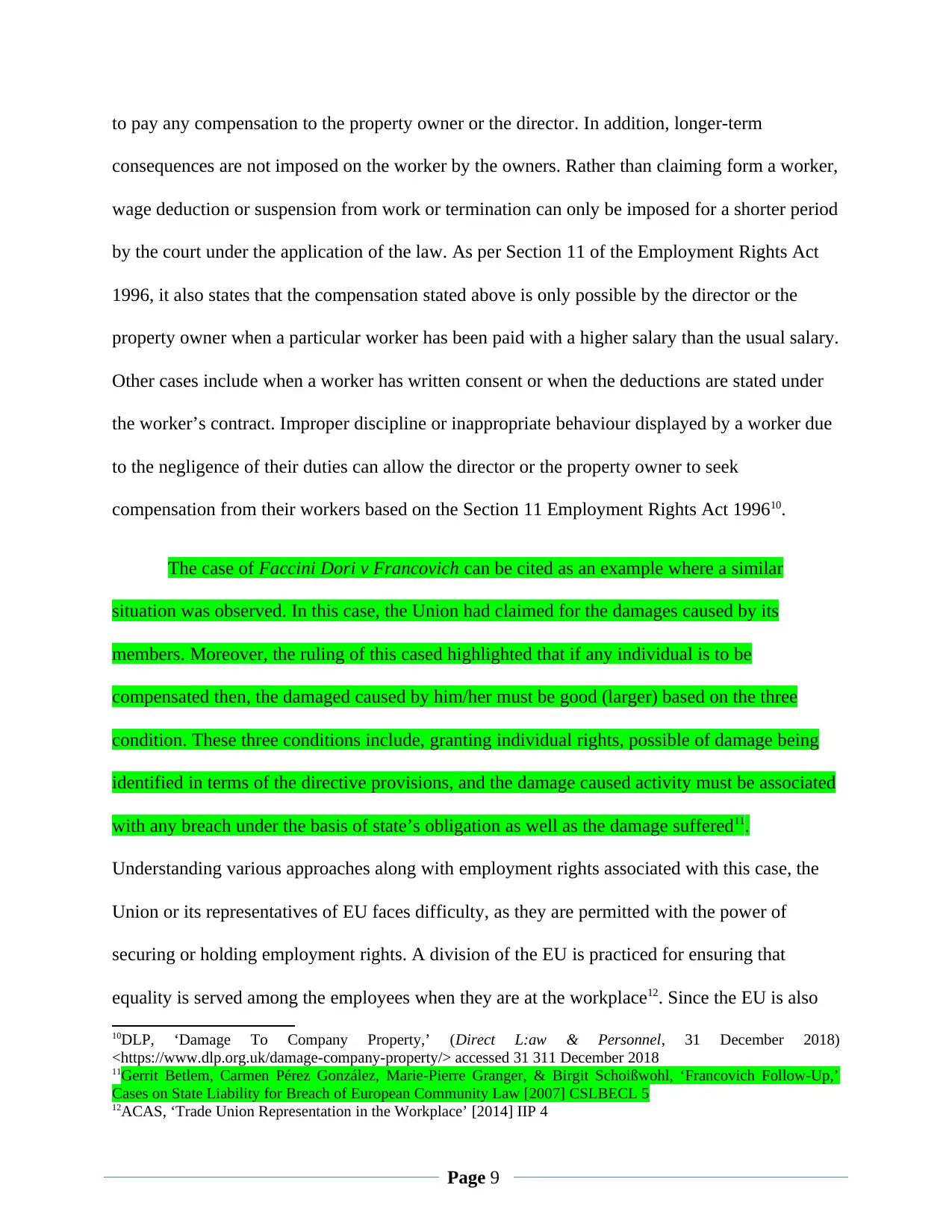
to pay any compensation to the property owner or the director. In addition, longer-term
consequences are not imposed on the worker by the owners. Rather than claiming form a worker,
wage deduction or suspension from work or termination can only be imposed for a shorter period
by the court under the application of the law. As per Section 11 of the Employment Rights Act
1996, it also states that the compensation stated above is only possible by the director or the
property owner when a particular worker has been paid with a higher salary than the usual salary.
Other cases include when a worker has written consent or when the deductions are stated under
the worker’s contract. Improper discipline or inappropriate behaviour displayed by a worker due
to the negligence of their duties can allow the director or the property owner to seek
compensation from their workers based on the Section 11 Employment Rights Act 199610.
The case of Faccini Dori v Francovich can be cited as an example where a similar
situation was observed. In this case, the Union had claimed for the damages caused by its
members. Moreover, the ruling of this cased highlighted that if any individual is to be
compensated then, the damaged caused by him/her must be good (larger) based on the three
condition. These three conditions include, granting individual rights, possible of damage being
identified in terms of the directive provisions, and the damage caused activity must be associated
with any breach under the basis of state’s obligation as well as the damage suffered11.
Understanding various approaches along with employment rights associated with this case, the
Union or its representatives of EU faces difficulty, as they are permitted with the power of
securing or holding employment rights. A division of the EU is practiced for ensuring that
equality is served among the employees when they are at the workplace12. Since the EU is also
10DLP, ‘Damage To Company Property,’ (Direct L:aw & Personnel, 31 December 2018)
<https://www.dlp.org.uk/damage-company-property/> accessed 31 311 December 2018
11Gerrit Betlem, Carmen Pérez González, Marie-Pierre Granger, & Birgit Schoißwohl, ‘Francovich Follow-Up,’
Cases on State Liability for Breach of European Community Law [2007] CSLBECL 5
12ACAS, ‘Trade Union Representation in the Workplace’ [2014] IIP 4
Page 9
consequences are not imposed on the worker by the owners. Rather than claiming form a worker,
wage deduction or suspension from work or termination can only be imposed for a shorter period
by the court under the application of the law. As per Section 11 of the Employment Rights Act
1996, it also states that the compensation stated above is only possible by the director or the
property owner when a particular worker has been paid with a higher salary than the usual salary.
Other cases include when a worker has written consent or when the deductions are stated under
the worker’s contract. Improper discipline or inappropriate behaviour displayed by a worker due
to the negligence of their duties can allow the director or the property owner to seek
compensation from their workers based on the Section 11 Employment Rights Act 199610.
The case of Faccini Dori v Francovich can be cited as an example where a similar
situation was observed. In this case, the Union had claimed for the damages caused by its
members. Moreover, the ruling of this cased highlighted that if any individual is to be
compensated then, the damaged caused by him/her must be good (larger) based on the three
condition. These three conditions include, granting individual rights, possible of damage being
identified in terms of the directive provisions, and the damage caused activity must be associated
with any breach under the basis of state’s obligation as well as the damage suffered11.
Understanding various approaches along with employment rights associated with this case, the
Union or its representatives of EU faces difficulty, as they are permitted with the power of
securing or holding employment rights. A division of the EU is practiced for ensuring that
equality is served among the employees when they are at the workplace12. Since the EU is also
10DLP, ‘Damage To Company Property,’ (Direct L:aw & Personnel, 31 December 2018)
<https://www.dlp.org.uk/damage-company-property/> accessed 31 311 December 2018
11Gerrit Betlem, Carmen Pérez González, Marie-Pierre Granger, & Birgit Schoißwohl, ‘Francovich Follow-Up,’
Cases on State Liability for Breach of European Community Law [2007] CSLBECL 5
12ACAS, ‘Trade Union Representation in the Workplace’ [2014] IIP 4
Page 9
⊘ This is a preview!⊘
Do you want full access?
Subscribe today to unlock all pages.

Trusted by 1+ million students worldwide
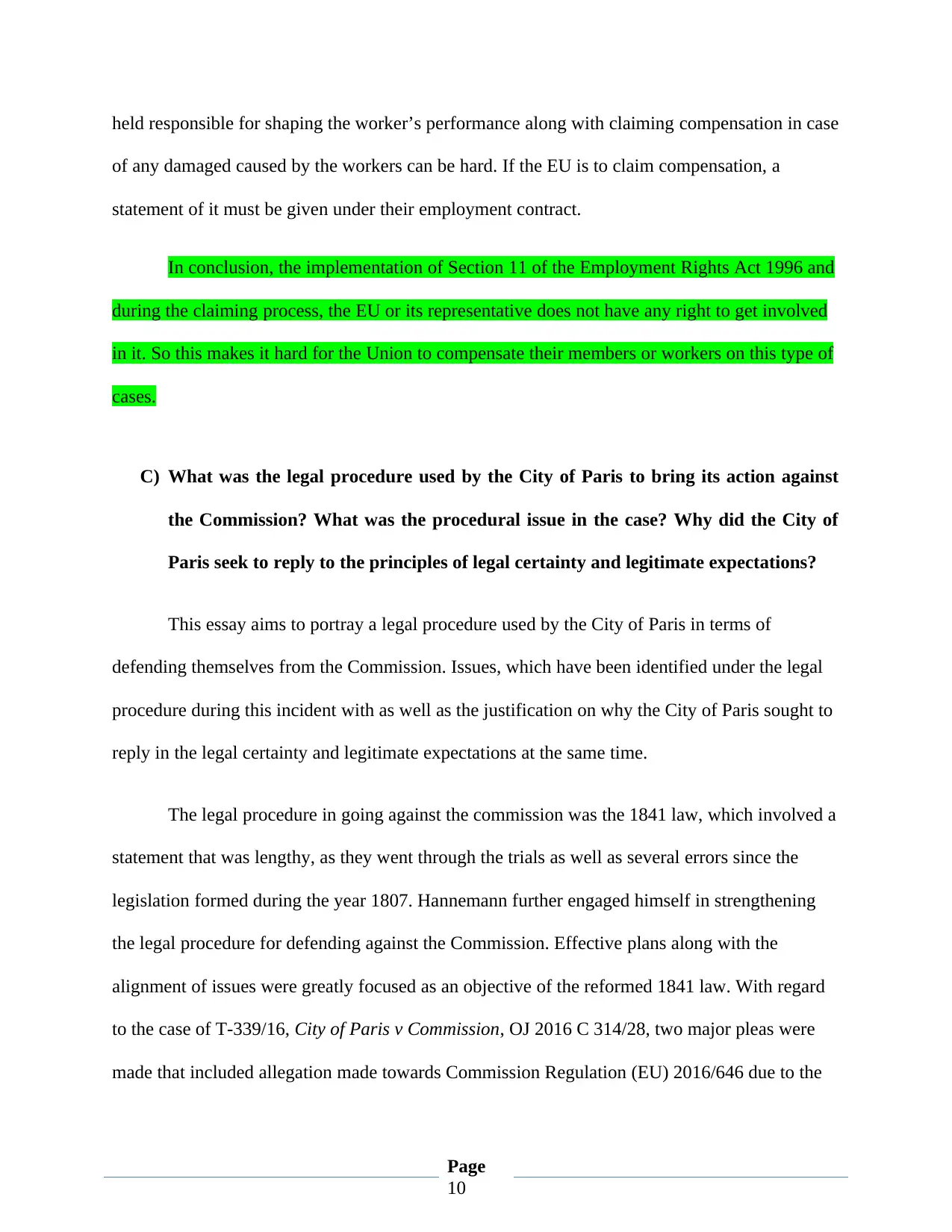
held responsible for shaping the worker’s performance along with claiming compensation in case
of any damaged caused by the workers can be hard. If the EU is to claim compensation, a
statement of it must be given under their employment contract.
In conclusion, the implementation of Section 11 of the Employment Rights Act 1996 and
during the claiming process, the EU or its representative does not have any right to get involved
in it. So this makes it hard for the Union to compensate their members or workers on this type of
cases.
C) What was the legal procedure used by the City of Paris to bring its action against
the Commission? What was the procedural issue in the case? Why did the City of
Paris seek to reply to the principles of legal certainty and legitimate expectations?
This essay aims to portray a legal procedure used by the City of Paris in terms of
defending themselves from the Commission. Issues, which have been identified under the legal
procedure during this incident with as well as the justification on why the City of Paris sought to
reply in the legal certainty and legitimate expectations at the same time.
The legal procedure in going against the commission was the 1841 law, which involved a
statement that was lengthy, as they went through the trials as well as several errors since the
legislation formed during the year 1807. Hannemann further engaged himself in strengthening
the legal procedure for defending against the Commission. Effective plans along with the
alignment of issues were greatly focused as an objective of the reformed 1841 law. With regard
to the case of T-339/16, City of Paris v Commission, OJ 2016 C 314/28, two major pleas were
made that included allegation made towards Commission Regulation (EU) 2016/646 due to the
Page
10
of any damaged caused by the workers can be hard. If the EU is to claim compensation, a
statement of it must be given under their employment contract.
In conclusion, the implementation of Section 11 of the Employment Rights Act 1996 and
during the claiming process, the EU or its representative does not have any right to get involved
in it. So this makes it hard for the Union to compensate their members or workers on this type of
cases.
C) What was the legal procedure used by the City of Paris to bring its action against
the Commission? What was the procedural issue in the case? Why did the City of
Paris seek to reply to the principles of legal certainty and legitimate expectations?
This essay aims to portray a legal procedure used by the City of Paris in terms of
defending themselves from the Commission. Issues, which have been identified under the legal
procedure during this incident with as well as the justification on why the City of Paris sought to
reply in the legal certainty and legitimate expectations at the same time.
The legal procedure in going against the commission was the 1841 law, which involved a
statement that was lengthy, as they went through the trials as well as several errors since the
legislation formed during the year 1807. Hannemann further engaged himself in strengthening
the legal procedure for defending against the Commission. Effective plans along with the
alignment of issues were greatly focused as an objective of the reformed 1841 law. With regard
to the case of T-339/16, City of Paris v Commission, OJ 2016 C 314/28, two major pleas were
made that included allegation made towards Commission Regulation (EU) 2016/646 due to the
Page
10
Paraphrase This Document
Need a fresh take? Get an instant paraphrase of this document with our AI Paraphraser
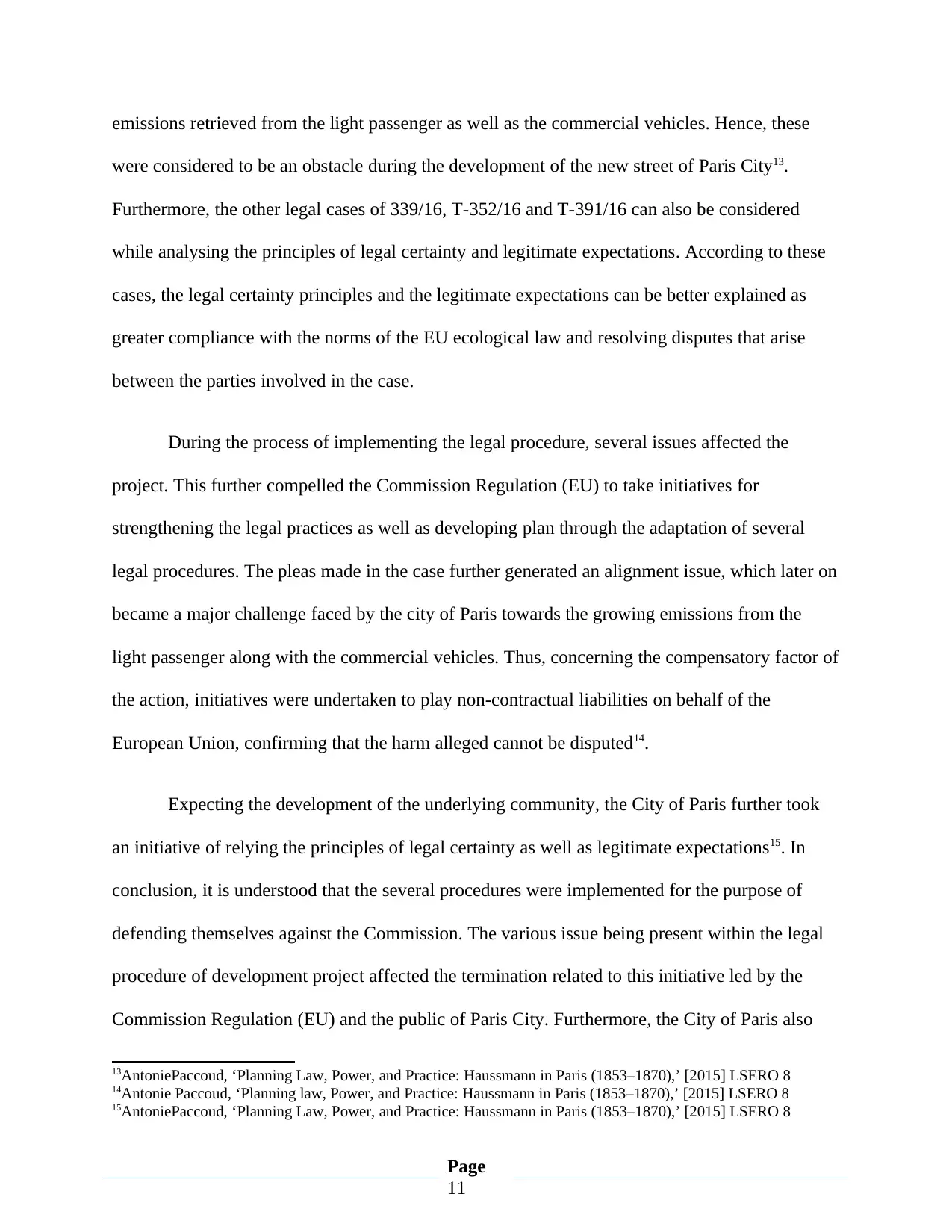
emissions retrieved from the light passenger as well as the commercial vehicles. Hence, these
were considered to be an obstacle during the development of the new street of Paris City13.
Furthermore, the other legal cases of 339/16, T-352/16 and T-391/16 can also be considered
while analysing the principles of legal certainty and legitimate expectations. According to these
cases, the legal certainty principles and the legitimate expectations can be better explained as
greater compliance with the norms of the EU ecological law and resolving disputes that arise
between the parties involved in the case.
During the process of implementing the legal procedure, several issues affected the
project. This further compelled the Commission Regulation (EU) to take initiatives for
strengthening the legal practices as well as developing plan through the adaptation of several
legal procedures. The pleas made in the case further generated an alignment issue, which later on
became a major challenge faced by the city of Paris towards the growing emissions from the
light passenger along with the commercial vehicles. Thus, concerning the compensatory factor of
the action, initiatives were undertaken to play non-contractual liabilities on behalf of the
European Union, confirming that the harm alleged cannot be disputed14.
Expecting the development of the underlying community, the City of Paris further took
an initiative of relying the principles of legal certainty as well as legitimate expectations15. In
conclusion, it is understood that the several procedures were implemented for the purpose of
defending themselves against the Commission. The various issue being present within the legal
procedure of development project affected the termination related to this initiative led by the
Commission Regulation (EU) and the public of Paris City. Furthermore, the City of Paris also
13AntoniePaccoud, ‘Planning Law, Power, and Practice: Haussmann in Paris (1853–1870),’ [2015] LSERO 8
14Antonie Paccoud, ‘Planning law, Power, and Practice: Haussmann in Paris (1853–1870),’ [2015] LSERO 8
15AntoniePaccoud, ‘Planning Law, Power, and Practice: Haussmann in Paris (1853–1870),’ [2015] LSERO 8
Page
11
were considered to be an obstacle during the development of the new street of Paris City13.
Furthermore, the other legal cases of 339/16, T-352/16 and T-391/16 can also be considered
while analysing the principles of legal certainty and legitimate expectations. According to these
cases, the legal certainty principles and the legitimate expectations can be better explained as
greater compliance with the norms of the EU ecological law and resolving disputes that arise
between the parties involved in the case.
During the process of implementing the legal procedure, several issues affected the
project. This further compelled the Commission Regulation (EU) to take initiatives for
strengthening the legal practices as well as developing plan through the adaptation of several
legal procedures. The pleas made in the case further generated an alignment issue, which later on
became a major challenge faced by the city of Paris towards the growing emissions from the
light passenger along with the commercial vehicles. Thus, concerning the compensatory factor of
the action, initiatives were undertaken to play non-contractual liabilities on behalf of the
European Union, confirming that the harm alleged cannot be disputed14.
Expecting the development of the underlying community, the City of Paris further took
an initiative of relying the principles of legal certainty as well as legitimate expectations15. In
conclusion, it is understood that the several procedures were implemented for the purpose of
defending themselves against the Commission. The various issue being present within the legal
procedure of development project affected the termination related to this initiative led by the
Commission Regulation (EU) and the public of Paris City. Furthermore, the City of Paris also
13AntoniePaccoud, ‘Planning Law, Power, and Practice: Haussmann in Paris (1853–1870),’ [2015] LSERO 8
14Antonie Paccoud, ‘Planning law, Power, and Practice: Haussmann in Paris (1853–1870),’ [2015] LSERO 8
15AntoniePaccoud, ‘Planning Law, Power, and Practice: Haussmann in Paris (1853–1870),’ [2015] LSERO 8
Page
11
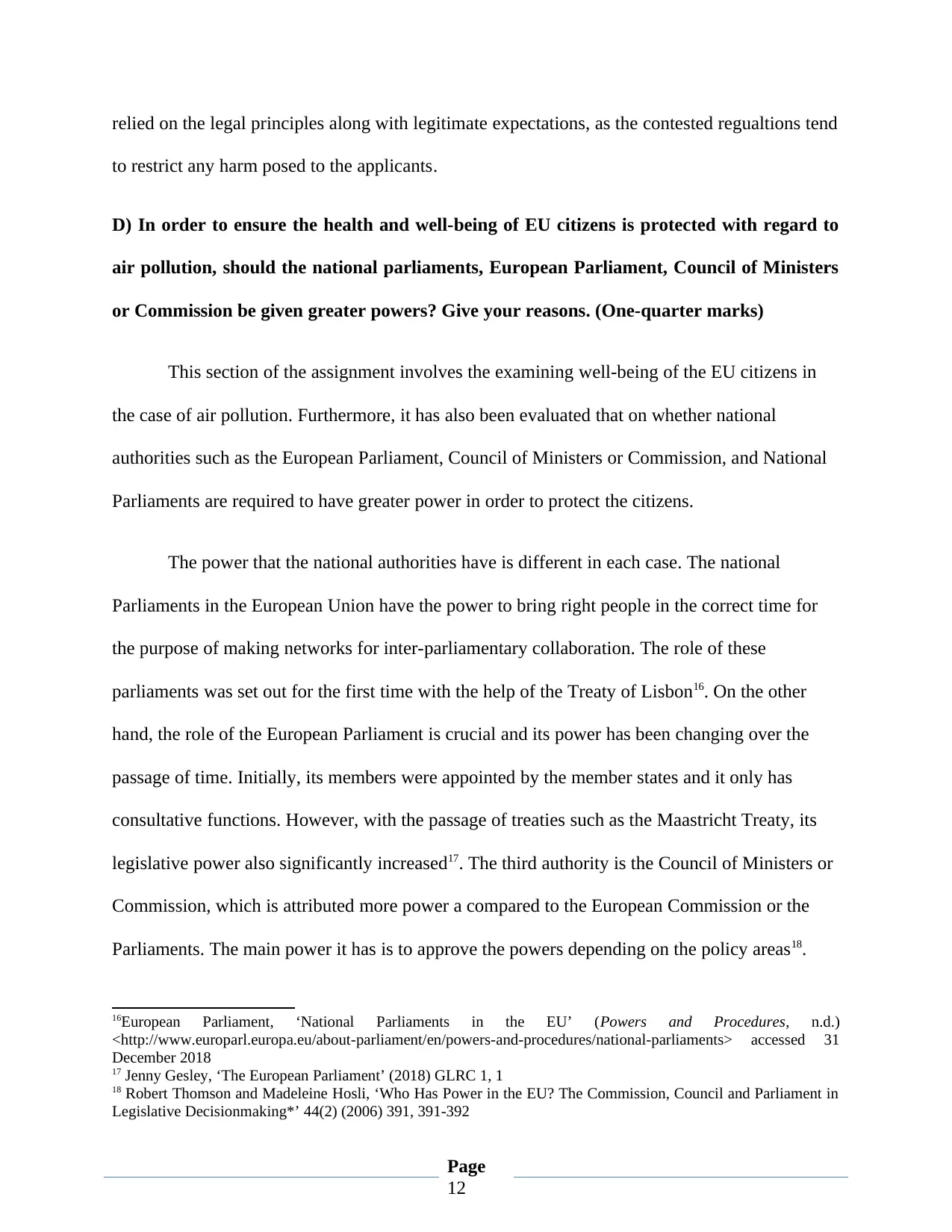
relied on the legal principles along with legitimate expectations, as the contested regualtions tend
to restrict any harm posed to the applicants.
D) In order to ensure the health and well-being of EU citizens is protected with regard to
air pollution, should the national parliaments, European Parliament, Council of Ministers
or Commission be given greater powers? Give your reasons. (One-quarter marks)
This section of the assignment involves the examining well-being of the EU citizens in
the case of air pollution. Furthermore, it has also been evaluated that on whether national
authorities such as the European Parliament, Council of Ministers or Commission, and National
Parliaments are required to have greater power in order to protect the citizens.
The power that the national authorities have is different in each case. The national
Parliaments in the European Union have the power to bring right people in the correct time for
the purpose of making networks for inter-parliamentary collaboration. The role of these
parliaments was set out for the first time with the help of the Treaty of Lisbon16. On the other
hand, the role of the European Parliament is crucial and its power has been changing over the
passage of time. Initially, its members were appointed by the member states and it only has
consultative functions. However, with the passage of treaties such as the Maastricht Treaty, its
legislative power also significantly increased17. The third authority is the Council of Ministers or
Commission, which is attributed more power a compared to the European Commission or the
Parliaments. The main power it has is to approve the powers depending on the policy areas18.
16European Parliament, ‘National Parliaments in the EU’ (Powers and Procedures, n.d.)
<http://www.europarl.europa.eu/about-parliament/en/powers-and-procedures/national-parliaments> accessed 31
December 2018
17 Jenny Gesley, ‘The European Parliament’ (2018) GLRC 1, 1
18 Robert Thomson and Madeleine Hosli, ‘Who Has Power in the EU? The Commission, Council and Parliament in
Legislative Decisionmaking*’ 44(2) (2006) 391, 391-392
Page
12
to restrict any harm posed to the applicants.
D) In order to ensure the health and well-being of EU citizens is protected with regard to
air pollution, should the national parliaments, European Parliament, Council of Ministers
or Commission be given greater powers? Give your reasons. (One-quarter marks)
This section of the assignment involves the examining well-being of the EU citizens in
the case of air pollution. Furthermore, it has also been evaluated that on whether national
authorities such as the European Parliament, Council of Ministers or Commission, and National
Parliaments are required to have greater power in order to protect the citizens.
The power that the national authorities have is different in each case. The national
Parliaments in the European Union have the power to bring right people in the correct time for
the purpose of making networks for inter-parliamentary collaboration. The role of these
parliaments was set out for the first time with the help of the Treaty of Lisbon16. On the other
hand, the role of the European Parliament is crucial and its power has been changing over the
passage of time. Initially, its members were appointed by the member states and it only has
consultative functions. However, with the passage of treaties such as the Maastricht Treaty, its
legislative power also significantly increased17. The third authority is the Council of Ministers or
Commission, which is attributed more power a compared to the European Commission or the
Parliaments. The main power it has is to approve the powers depending on the policy areas18.
16European Parliament, ‘National Parliaments in the EU’ (Powers and Procedures, n.d.)
<http://www.europarl.europa.eu/about-parliament/en/powers-and-procedures/national-parliaments> accessed 31
December 2018
17 Jenny Gesley, ‘The European Parliament’ (2018) GLRC 1, 1
18 Robert Thomson and Madeleine Hosli, ‘Who Has Power in the EU? The Commission, Council and Parliament in
Legislative Decisionmaking*’ 44(2) (2006) 391, 391-392
Page
12
⊘ This is a preview!⊘
Do you want full access?
Subscribe today to unlock all pages.

Trusted by 1+ million students worldwide
1 out of 18
Your All-in-One AI-Powered Toolkit for Academic Success.
+13062052269
info@desklib.com
Available 24*7 on WhatsApp / Email
![[object Object]](/_next/static/media/star-bottom.7253800d.svg)
Unlock your academic potential
Copyright © 2020–2025 A2Z Services. All Rights Reserved. Developed and managed by ZUCOL.
